Markets Swing as U.S.-China Trade War Escalates
- The economic data calendar was pretty quiet this week, but financial markets have been anything but stable. Equity markets plunged and the 10-year Treasury fell to its lowest rate in three years on Tuesday as trade tensions escalated.
- At the end of last week, President Trump said the U.S. would move forward with a 10% tariff on the remaining $300 billion of imports from China. We do not think this is an idle threat.
- While consumers would more directly be in the crossfire with this round, we still suspect the direct effects to be manageable. The indirect effects, however, could provide a further nudge to the Fed for more policy easing this year.
Markets Swing as U.S.-China Trade War Escalates
The economic data calendar was pretty quiet this week, but financial markets have been anything but stable. Markets opened on Monday to news that China’s onshore USD/CNY exchange rate traded beyond the symbolic 7.00 per dollar for the first time in more than 10 years. This occurred in the wake of President Trump tweeting on August 1 that, “…the U.S. will start, on September 1st, putting a small additional Tariff of 10% on the remaining 300 Billion Dollars of goods and products coming from China into our Country.” The S&P 500 index plunged 87 bps on Monday— marking the largest daily drop this year (chart on first page)—and the yield on the 10-year Treasury fell to its lowest rate in three years on Tuesday (top chart) as investors flocked to safer assets. Financial markets were outright shaken by global developments, but as the week progressed, markets regained most of their lost ground.
We suspect the 10% tariff on an additional $300 billion of imports from China goes into effect, and given the public comment period—which is required prior to tariff implementation—has already been observed, we suspect the announced September 1 effective date as a realistic baseline. If implemented, this new round in the trade-spat leaves consumers directly in the crossfire. Previous bouts of tariffs, like those on the steel and aluminum, have mostly been aimed further up the production pipeline. But this new round impacts finished goods like consumer electronics, toys and clothing. So whereas tariffed inputs were previously only part of a finished goods’ final cost, with the full value of many finished goods now subject to tariffs, there is less scope for businesses to absorb the additional cost. We therefore expect at least some of the tariffs that importers pay will be passed on to consumers via higher prices. We estimate the 10% tariff will add a little over 0.1 percentage point to the year-over-year rate of CPI inflation. While that may seem small, goods represent only a fraction of the inflation basket (middle chart). We do not suspect tariffs will derail consumer spending, but they do have the potential to shift wallet share and weigh on confidence.
For a FOMC that has stated a concern over global headwinds to the outlook, the escalation in the trade-war could further tip the scales toward more policy easing this year. Fed speak this week has referenced that a more uncertain trade outlook could warrant lower interest rates, but no one has specified when. While global growth is not specifically part of the FOMC’s mandate, and we believe the direct impact from trade tensions still looks to be fairly manageable, the indirect effects to confidence, profits and investment give more reason for concern. As such, we suspect the FOMC is not finished with its “mid-cycle adjustment” quite yet. But, rather than waiting until October to cut rates again, we now expect the FOMC to cut rates 25 bps in September. We do acknowledge the risks to this forecast are tilted toward more easing rather than less. Recent market turmoil has also caused a jump in market implied probabilities of a rate cut in September. Markets have now priced in a rate cut in September as a near certain event, as the probability jumped to 100% at the end of last week.
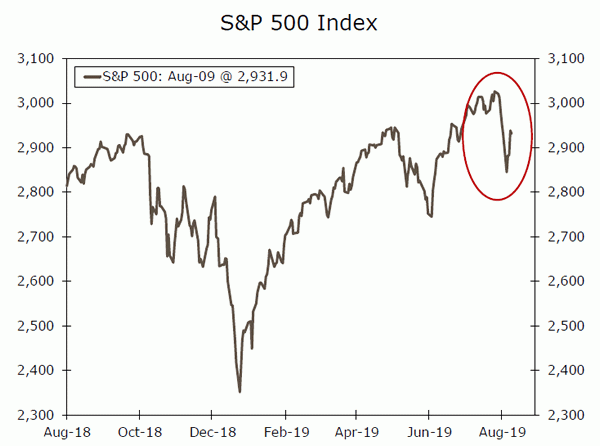
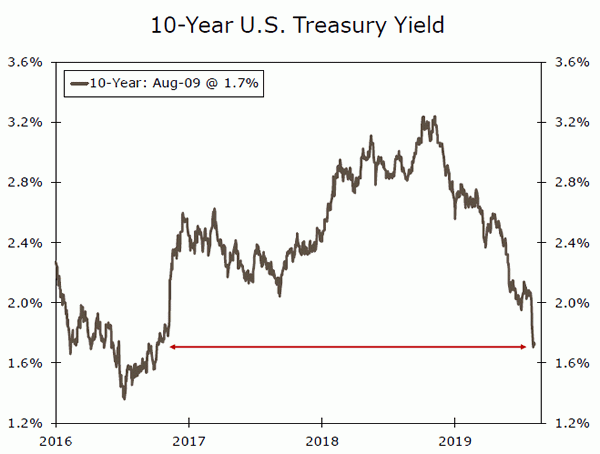
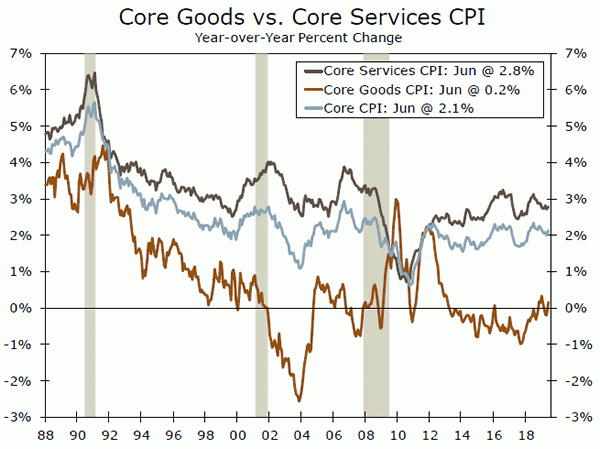
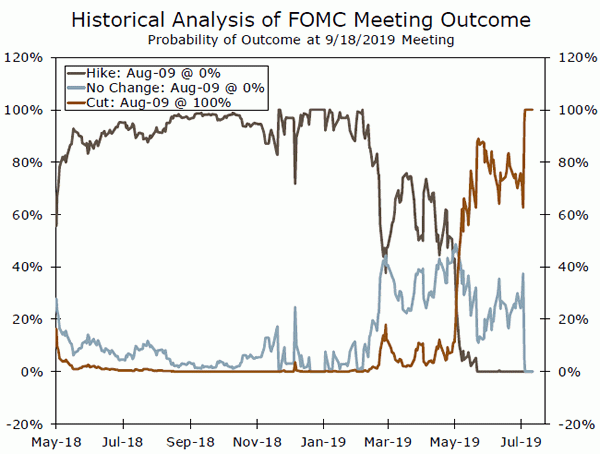
CPI • Tuesday
Oil prices have driven volatility in overall consumer price inflation during the first half of the year. Energy prices declined in May and June, leading to back-to-back, modest 0.1% increases in headline CPI following more substantial gains in the prior three months. Core consumer prices showed some signs of life in June, rising 0.3% on the month, breaking a string of 0.1% gains during the past four months. That being said, the inflation backdrop remains tame as we look ahead to the second half of the year.
The proposed 10% tariff on the remaining $300 billion worth of Chinese imports (largely consumer goods) has sparked some concerns about inflation. However, we estimate the latest round of tariffs would add a little over 0.1 percentage points to the year-overyear rate of CPI inflation. This relatively small increase is largely because goods make up only a fraction of the CPI.
Previous: 0.1% Wells Fargo: 0.2% Consensus: 0.3% (Month-over-Month)
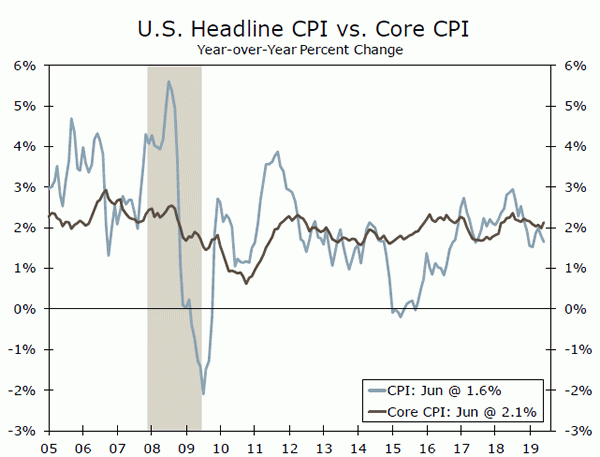
Retail Sales • Thursday
Aside from a decline in February, retail sales have increased every month so far this year. That’s consistent with the elevated confidence data and suggests consumers remain comfortable with their spending habits despite increased risks to the outlook.
Retail sales ended the second quarter on a strong note, as growth was broad based with 11 of the 13 retail categories increasing in June. Sales in the “control group” (excluding autos, gasoline and building materials, and a key gauge of underlying consumer spending) have been exceptionally strong in recent months with the three-month annualized rate at 7.5% in June.
With manufacturing and investment continuing to bear the brunt of an escalated trade war, consumer spending remains the primary driver of U.S. GDP growth. As long as the labor market remains healthy, this positive consumer spending trend should continue.
Previous: 0.4% Wells Fargo: 0.3% Consensus: 0.3% (Month-over-Month)
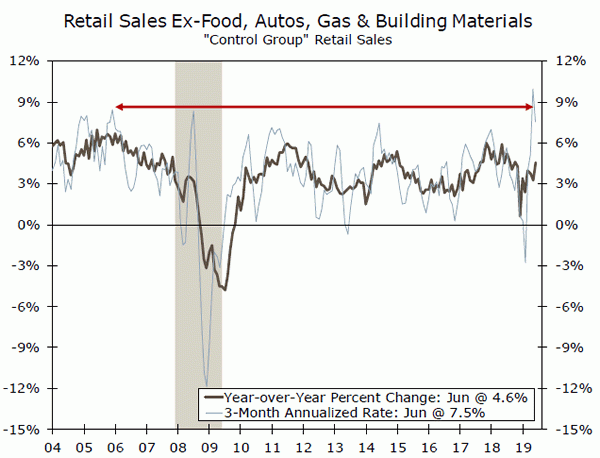
Industrial Production • Thursday
Slowing global demand and the ongoing trade war have certainly weighed on the factory sector over the past six months. Manufacturing activity has cooled sharply relative to 2018, though there have been some recent signs of stabilization.
Production has rebounded over the past two months, following the previous four months of, on net, contraction. The strength of motor vehicle production has been a core driver of recent growth, though solid consumer demand has also underpinned the sector.
Total industrial production, which also includes mining and utilities, contracted at a 1.2% annualized rate in Q2 following a 1.9% decline in Q1—marking the first instance of consecutive IP declines since Q2-2016. We look for industrial production to improve over coming quarters; however, substantial headwinds remain in place, thereby limiting growth prospects.
Previous: 0.0% Wells Fargo: -0.1% Consensus: 0.1% (Month-over-Month)
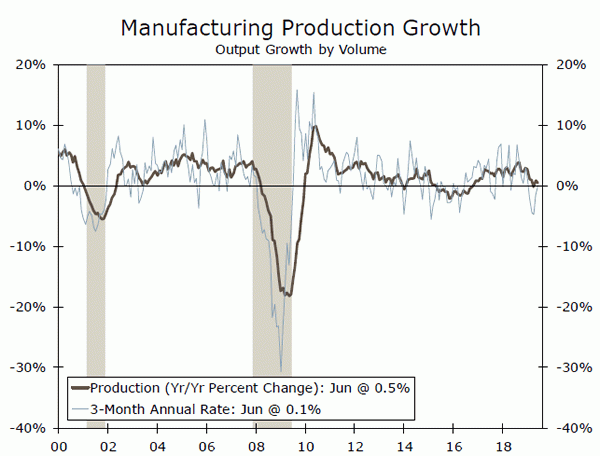
Downside Risks in Focus as Trade Tensions Intensify
- This week saw a further escalation in trade tensions as the renminbi traded through the psychological 7.00 per dollar level and China asked some companies to suspend U.S. agricultural imports from the U.S., while the U.S. Treasury labeled China a currency manipulator.
- Concerned about the economic fallout, there was a flurry of rate cuts this week from Asian central banks including New Zealand, India, Thailand and the Philippines.
- After a solid start to 2019, the U.K. economy unexpectedly shrank in Q2. Services output edged higher, but there was a noticeable decline in both manufacturing and exports.
Plenty of Action From Asia-Pacific Central Banks
Asian central banks joined the global rate cut party in a big way this past week, led by the Reserve Bank of New Zealand, who lowered their Official Cash Rate by an aggressive 50 basis points to a record low of 1.00%. That rate cut was larger than expected, and the comments surrounding the rate cut were notably dovish. Central bank governor Orr signaled that further monetary easing could be possible, and even that non-conventional monetary policy measures were within the realm of possible outcomes. Although NZ activity indicators have been reasonable without being especially strong, confidence surveys have softened, meaning that further NZ monetary easing seems likely.
After rate cuts in both June and July, the Reserve Bank of Australia (RBA) sat on the sidelines this month, keeping its Cash Rate at 1.00%. However, it may not be that long before Australia’s central bank rejoins the monetary easing trend. The RBA said it would ease monetary policy further if needed to support sustainable growth and achieve its inflation target and, in newly introduced language, said it is reasonable to expect that an extended period of low interest rates will be required. The RBA also lowered its GDP growth and CPI inflation forecasts in its Statement on Monetary Policy, perhaps hinting that further easing is quite likely in the next few months.
Elsewhere in Asia central banks were also active in lowering interest rates. The Reserve Bank of India cut its benchmark policy interest rates by an unusual 35 basis points, including lowering its repo rate to 5.40%, citing a cyclical slowdown in the economy as it lowered its GDP growth forecasts, while also saying that CPI inflation should remain benign. In Thailand the central bank surprised economists with a 25 basis point cut in the policy rate to 1.50%, saying the economy is expected to slow, inflation may be below target, and that it continues to monitor the impact of the trade war. The Bank of Thailand also said it has “policy space left” after this week’s action and that further policy moves will be data dependent. Finally, the Philippine central bank also cut its overnight borrowing rate 25 basis points to 4.25% following a recent slowing in both GDP growth and CPI inflation.
U.K. Economy Stalls in Second Quarter
After a solid start to 2019, the U.K. economy unexpectedly shrank in Q2 as Brexit uncertainties weighed more noticeably on growth. Q2 GDP fell 0.2% quarter-over-quarter and slowed to 1.2% year-over-year. Q2 consumer spending was solid in Q2 showing a gain of 0.5% quarter-over-quarter, but the more business-oriented elements of the economy were soft. Q2 business investment fell 0.5% quarter-over-quarter, while exports fell by 3.3%. By sector, services activity edged up 0.1% quarter-overquarter, but that gain was offset by a 1.4% fall in industrial output. For now we view the Bank of England as reasonably comfortably on hold. With economic growth subdued and while Brexit uncertainty hangs over the economy we see rate hikes as unlikely, although with CPI inflation also close to target we also do not see U.K. monetary easing as likely for now.
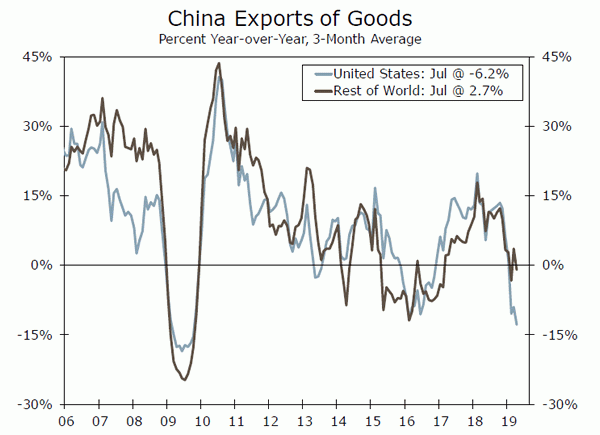
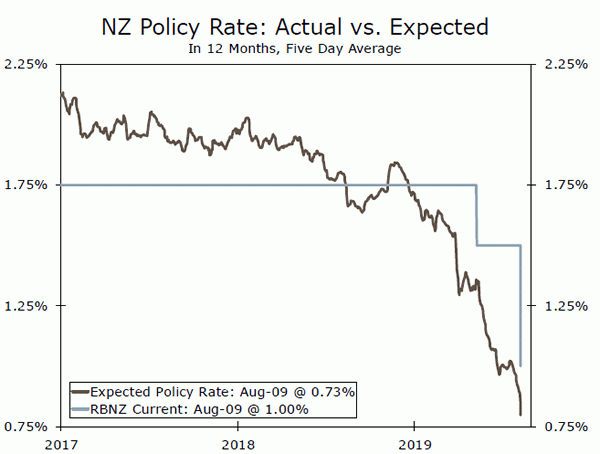
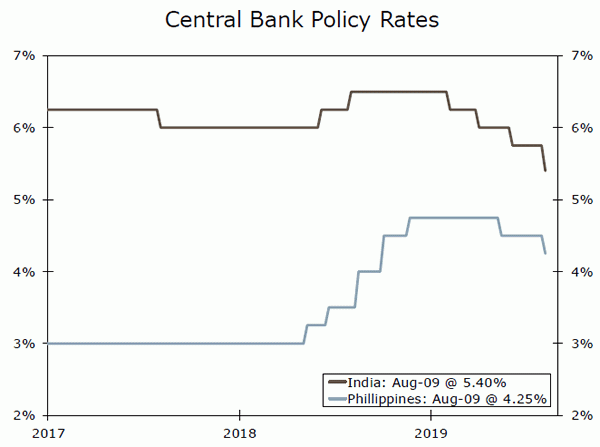
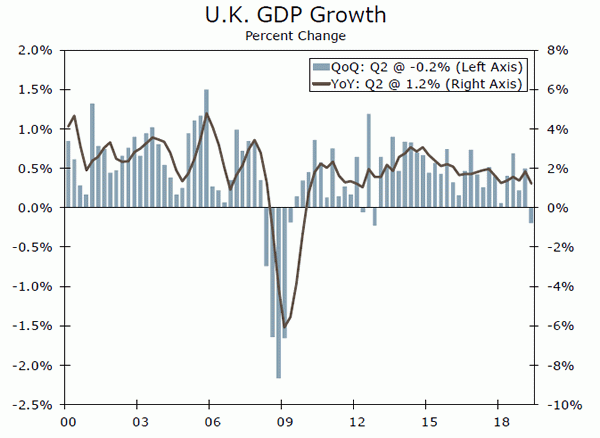
China Retail Sales • Wednesday
The fortunes of the Chinese economy have been a key focus of investors this year, especially as trade tensions between China and the United States have ratcheted higher. GDP growth continued its gradually slowing trend to 6.2% year-over-year in Q2 and, while June activity data were firm and July confidence surveys were mixed.
This week’s batch of Chinese economic figures may show that the strong finish to the second quarter gave way to a softer start to the third quarter. The consensus forecast is for July retail sales to slow to 8.6% year-over-year, while growth in industrial output is also expected to slow modestly to 6.0% year-over-year. These figures of course will not reflect either the direct or indirect effects of the latest tariff increases, which were announced in early August and will go in to effect on September 1. Given ongoing uncertainty and the prospect of slowing exports, investment and manufacturing, we expect China’s GDP growth to slow further t0 5.8% in 2020.
Previous: 9.8% Consensus: 8.6% (Year-over-Year)
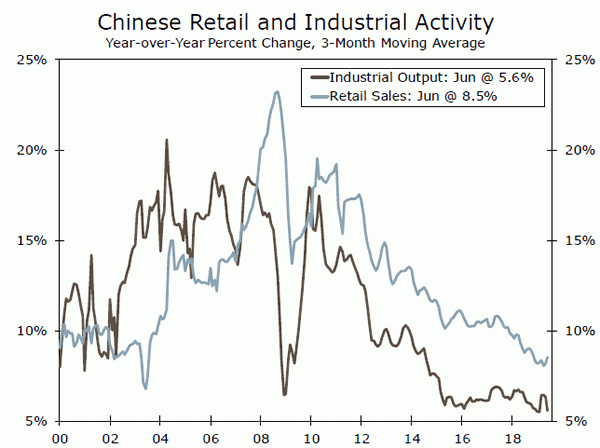
U.K. CPI • Wednesday
The U.K. economy has shown varying goldilocks elements in recent months, and all three data bowls of economic porridge may be on display next week. Wage growth is, perhaps, in the “too hot” category, with average weekly earnings forecast to quicken further to 3.7% year-over-year for Q2. Meanwhile, activity growth has recently been in the “too cold” category. U.K. Q2 employment is expected to rise by a moderate 67,000 compared to Q1, while July retail sales are forecast to fall 0.3% month-over-month, which would be the third decline in the past four months.
Finally, July CPI inflation released next week will likely remain close to the “just right” category. The headline CPI is expected to slow to 1.9% year-over-year, in part on lower energy prices, and the core CPI should rise 1.8%. Both of those outcomes would be close to the central bank’s inflation target midpoint, and we believe the Bank of England is likely to remain on hold for some time.
Previous: 2.0% Wells Fargo: 1.9% Consensus: 1.9%% (Year-over-Year)
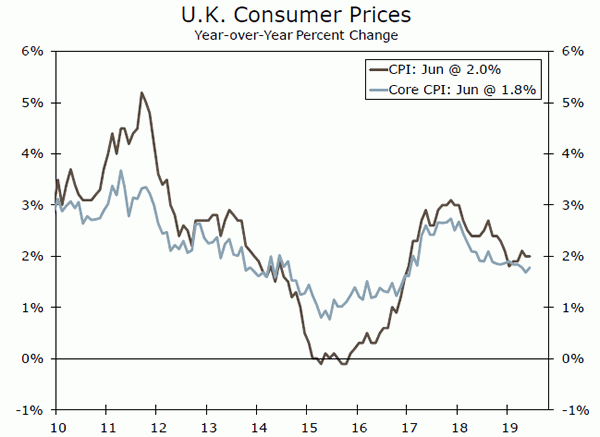
Mexico Overnight Rate • Friday
The Bank of Mexico announces its latest monetary policy decision next week, at which we think it will initiate a rate cut cycle, joining a plethora of global central banks that have already begun easing monetary policy. Mexico’s economy has cooled perceptibly in 2019. Q2 GDP edged up 0.1% quarter-over-quarter but fell 0.7% year-over-year—the latter being the first annual decline in GDP since late 2009. Meanwhile inflation has also slowed with CPI rising just 3.8% year-over-year in July, and the core CPI also rising 3.8%.
Considering some recent weakness in the Mexican peso we do not expect the central bank to lower rates aggressively next week, but we do see a 25 basis point reduction in the overnight rate to 8.00%. Even after that move, the real policy interest rate would still be at a high level and, given the loss of momentum in the economy, we expect the Bank of Mexico to lower interest rates further before the end of 2019.
Previous: 8.25% Wells Fargo: 8.00% Consensus: 8.00%
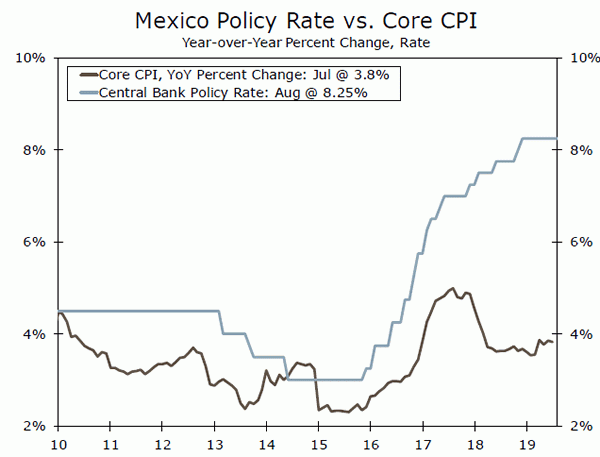
Interest Rate Watch
Bond Yields Fall Sharply
The yield on the 10-year Treasury security, which has been declining steadily since November, fell this week to its lowest level since July 2016 (top chart). But the United States is not the only economy that has seen its sovereign bond yields recently fall sharply. For example, the yield on the 10-year government bond in Germany touched an all-time low of -0.60% this week (middle chart). Indeed, the entire yield curve in Germany (out to 30 years) is negative presently, while the yield on the 10-year government bond in Japan is about -0.20% at present. What is driving bond yields so low?
For starters, recent central bank policy decisions are helping to depress yields. Central banks in Thailand, the Philippines, Peru and Serbia all cut policy rates by 25 bps this week, while the Reserve Bank of India reduced its policy rates by 35 bps and the Reserve Bank of New Zealand slashed rates by 50 bps. Investors expect that some major central banks such as the Federal Reserve and the ECB will also cut rates further in coming weeks and months. Furthermore, many analysts, ourselves included, look for the ECB to start up its quantitative easing program again next month.
Of course, there is angst about what the escalation of the trade war between the United States and China means for economic growth, not only in those two large economies but also for the global economy. Inflation rates in most countries are low already, and further slowing in growth would put more downward pressure on inflation. In that regard, the spread between the yield on the 10-year Treasury security and the 10-year inflation-protected Treasury security, which is a market-based measure of inflation expectation over the next 10 years, continues to sink lower and lower (bottom chart).
As we wrote in our recent Monthly Economic Outlook, we look for the FOMC to cut rates by another 25 bps at its next policy meeting on September 18. But as we readily acknowledge, continued economic uncertainty and financial market volatility could easily induce the FOMC to cut rates even further in coming months.
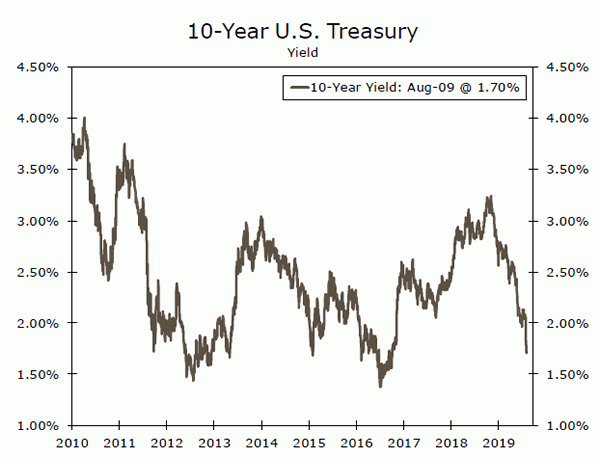
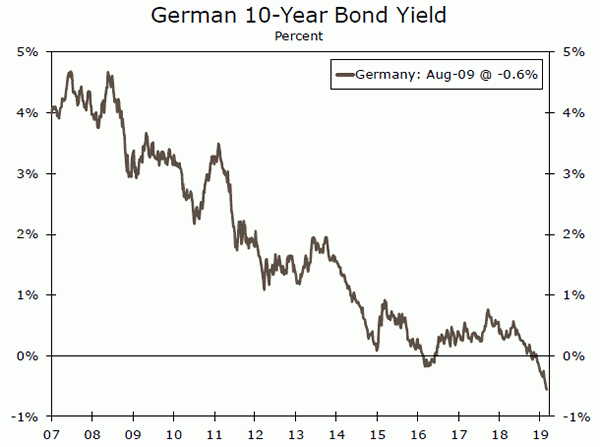
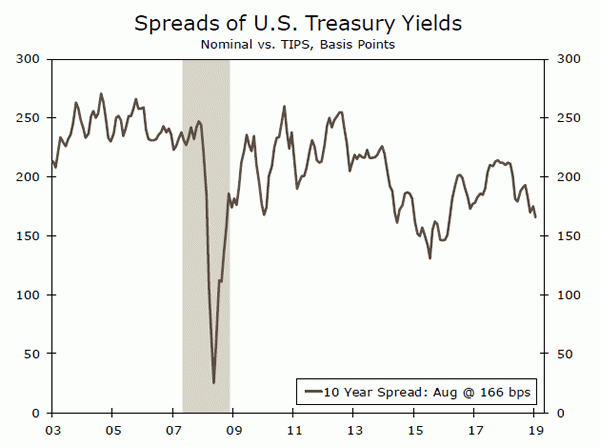
Credit Market Insights
Strength in Consumer Credit Demand
Consumer credit rose $14.6 billion in June, which was below expectations and the slowest monthly change in three months. While the gain was less than the $16.0 billion average monthly change this past year, it remains above the average $13.0 billion gain seen this expansion.
The entirety of the increase came from nonrevolving debt, up $14.7 billion, while revolving debt—mostly comprised of credit card loans—fell $80.5 million. We suspect the high annual percentage rate (APR) on credit card agreements may be weighing on this form of borrowing. The average APR rose to 15.13 in Q2, which marks the highest rate since 2001. Some consumers can expect to see a lower APR on their upcoming statements however, as the FOMC’s 25 bps rate cut last week encourages banks to decrease their prime rate.
Consumer demand for credit remains strong. Survey data from the Fed showed loan officers citing broad strength in consumer credit demand in Q2. However, banks reportedly tightened standards on consumer loans. Notably, the percentage of banks tightening credit card standards reached its highest level since 2009 in the first half of this year. These stricter standards may reflect credit holders’ growing uncertainty about the stability of consumer credit. Although, with the tight labor market, steady wage growth and an elevated personal saving rate, we expect that the consumer remains in a good position to service their debts at this time.
Topic of the Week
Renminbi Slips and Slides
The past week has been a remarkable one for monetary policy, trade policy, and price action in the foreign exchange markets. Most significantly, China’s onshore USD/CNY exchange rate has traded beyond 7.00 per dollar for the first time since 2008.
Clearly, traders and investors are comfortable with the prospects of a weaker Chinese currency at this juncture. The natural follow-up questions are whether this is reflective of China’s economic fundamentals, and whether Chinese policymakers will allow for such a decline. We view China’s economic fundamentals as consistent with a weaker currency. China’s Q2 GDP growth slowed to 6.2% year-over-year, and we forecast a further slowdown to 6.1% in 2019 and 5.8% in 2020. Moreover, considering the trade disruptions through the course of this year we believe the risks to those growth forecasts are tilted to the downside. Given the likelihood of further Chinese policy easing (for example, further cuts in the Reserve Requirement Ratio), we suspect the trends of China’s economy and overall policy response could lead to further renminbi softness overtime.
We believe that international pressure, including the U.S. naming China a currency manipulator, is unlikely to significantly dissuade Chinese authorities from softening the currency further. However, Chinese authorities have been wary of encouraging expectation of renminbi depreciation, for fears of destabilizing China’s financial markets. Accordingly, we do not expect China to sanction a rapid renminbi decline. That said, we do believe the policy calculus has changed somewhat when compared to recent episodes, given the U.S./China trade tensions and ongoing Chinese economic slowdown, which we believe will mean authorities will be more accommodative of gradual renminbi depreciation, even in the face of U.S. pressures. With that in mind, we see some further modest renminbi weakness in the coming months.
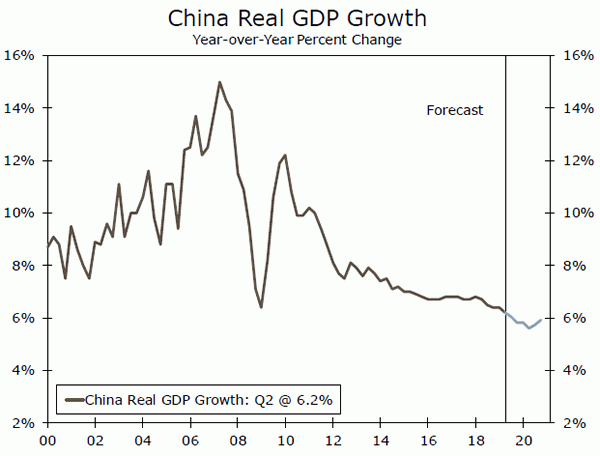
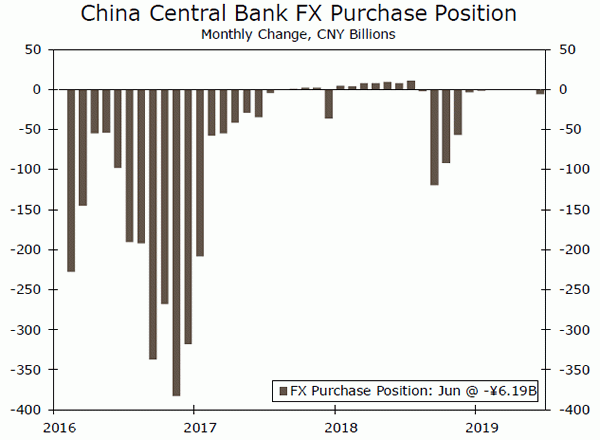


 Signal2forex.com - Best Forex robots and signals
Signal2forex.com - Best Forex robots and signals




